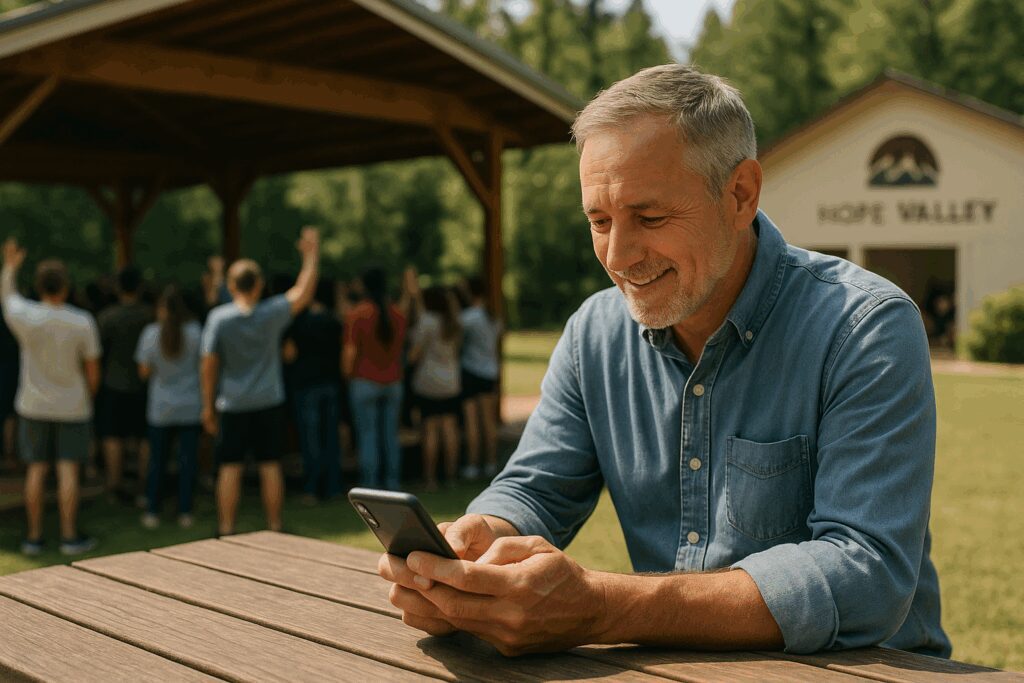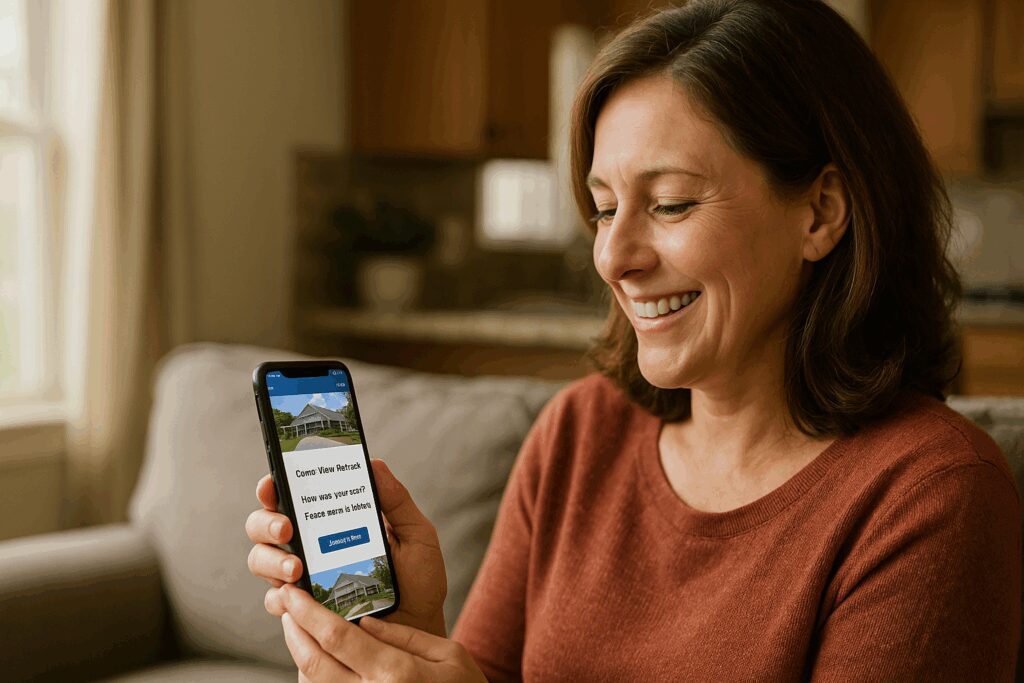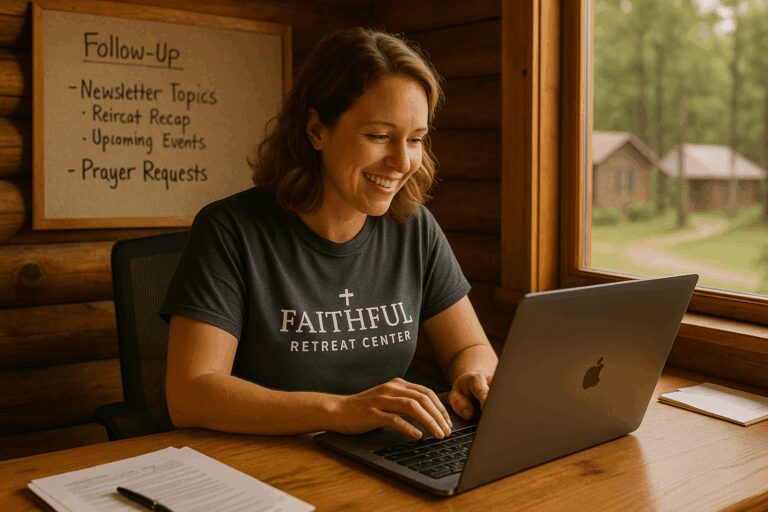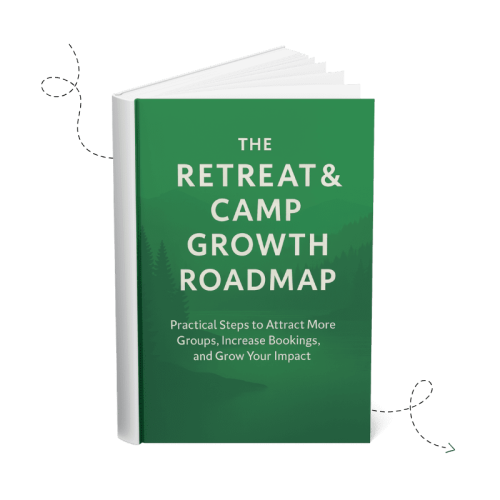Retreat & Camp Growth Roadmap Step: Expand Customer Engagement
Introduction
For many retreat centers and camps, the guest experience ends at checkout. But what if that was just the beginning? If you already go the extra mile to serve guests onsite, this step helps you continue that hospitality long after they’ve left. “Expand Customer Engagement” helps you build lasting relationships with your guests, staying top-of-mind and nurturing the kind of trust that leads to rebookings, referrals, and reviews.
This step in the Retreat & Camp Growth Roadmap ties together email and SMS communication, social media presence, and online reputation management. By implementing these practices, you can extend the impact of each retreat, deepen guest loyalty, and grow your ministry more sustainably.
Why This Step Matters
People don’t just return to places—they return to relationships. When you engage past guests with care and consistency, you’re doing more than marketing: you’re stewarding connections that were already formed onsite.
From a ministry standpoint, this is an opportunity to encourage, uplift, and keep the spiritual and relational momentum going. From a marketing lens, it strengthens retention, amplifies word-of-mouth, and improves online visibility—all of which fuel long-term growth.
The best part? With the right systems in place, you can do this without overwhelming your team. Email and SMS tools, social media planning, and review automation allow you to serve past guests well, even while welcoming new ones.
Is This a Step You Need to Focus on Right Now?
Consider the following:
- Do you only communicate with past guests when it’s time to rebook?
- Is your social media activity sporadic and announcement-based?
- Are your reviews concentrated on one platform while others sit empty?
- Do you lack a consistent way to ask guests for reviews or testimonials?
- Is your email list underused or non-existent?
If you answered “yes” to any of these, this step can help you bring greater connection, visibility, and rebooking momentum to your ministry.
Putting This Step into Practice
This step is built on three interconnected focus areas: email/SMS blasts, organic social content, and review automation. Together, they form a powerful rhythm of guest engagement that keeps your message alive long after checkout.
Send Email & SMS Blasts
The goal here isn’t to flood inboxes. It’s to provide meaningful, mission-aligned touchpoints that remind guests of your ministry and invite continued connection. Segmenting your list—for example, retreat planners, past campers, or local families—lets you tailor your messages for relevance and engagement.
Many retreat centers and camps use simple email tools (like Mailchimp or Constant Contact) to send:
- Seasonal updates and devotionals
- Behind-the-scenes stories
- Registration reminders
- Booking availability alerts
- Invitations to special events or family days
The key is consistency. A monthly or quarterly rhythm is enough to stay top-of-mind without overwhelming your team or your guests. And with SMS, you can add brief, timely nudges like “We’d love to see your group back this fall” or “Have you picked your summer week yet?”. It’s to provide meaningful, mission-aligned touchpoints that remind guests of your ministry and invite continued connection.
Many retreat centers and camps use simple email tools (like Mailchimp or Constant Contact) to send:
- Seasonal updates and devotionals
- Behind-the-scenes stories
- Registration reminders
- Booking availability alerts
- Invitations to special events or family days
The key is consistency. A monthly or quarterly rhythm is enough to stay top-of-mind without overwhelming your team or your guests. And with SMS, you can add brief, timely nudges like “We’d love to see your group back this fall” or “Have you picked your summer week yet?”
🔗 [Read the full Send Email & SMS Blasts Focus Area Article]
📥 [Download the Send Email & SMS Blasts Worksheet]

Post Social Media Content
Social media can do more than just make announcements—it can cultivate relationships. This focus area helps you shift from sporadic posting to a sustainable rhythm of engagement. Incorporating guest-generated content (with permission) can enrich your feed and lessen the content creation burden on your staff.
Effective social content includes:
- Photos of recent groups enjoying your property
- Stories and testimonials from guests
- Short videos or reels that show daily life at your center
- Staff spotlights and prayer requests
- Encouraging Scripture or seasonal reflections
The article outlines how to build a 2-week or monthly content plan, use scheduling tools, and integrate AI helpers without losing authenticity. This makes it easier to stay consistent while still sounding like you. make announcements—it can cultivate relationships. This focus area helps you shift from sporadic posting to a sustainable rhythm of engagement.
Effective social content includes:
- Photos of recent groups enjoying your property
- Stories and testimonials from guests
- Short videos or reels that show daily life at your center
- Staff spotlights and prayer requests
- Encouraging Scripture or seasonal reflections
The article outlines how to build a 2-week or monthly content plan, use scheduling tools, and integrate AI helpers without losing authenticity. This makes it easier to stay consistent while still sounding like you.
🔗 [Read the full Post Social Media Content Focus Area Article]
📥 [Download the Post Social Media Content Worksheet]

Automate Review Requests
Most retreat centers rely on guests to leave reviews on their own—but that often means only the most enthusiastic (or unhappy) ones do. This focus area introduces a fairer, more consistent approach: automated review requests. It also helps you balance review visibility across platforms by rotating requests between Google, Facebook, TripAdvisor, and others over time.
When you automate review requests to go out 24–48 hours after a retreat, camp session, or event, you:
- Increase review volume across platforms (Google, Facebook, TripAdvisor)
- Improve search visibility (especially for local SEO)
- Get valuable guest feedback for internal improvement
The article walks through how to set up trigger-based emails and texts, rotate between platforms, and even log offline testimonials. With tools like LeadHub CRM, you can manage the entire process without burdening your staff. to leave reviews on their own—but that often means only the most enthusiastic (or unhappy) ones do. This focus area introduces a fairer, more consistent approach: automated review requests.
When you automate review requests to go out 24–48 hours after a retreat, camp session, or event, you:
- Increase review volume across platforms (Google, Facebook, TripAdvisor)
- Improve search visibility (especially for local SEO)
- Get valuable guest feedback for internal improvement
The article walks through how to set up trigger-based emails and texts, rotate between platforms, and even log offline testimonials. With tools like LeadHub CRM, you can manage the entire process without burdening your staff.
🔗 [Read the full Automate Review Requests Focus Area Article]
📥 [Download the Automate Review Requests Worksheet]

Mini Case Study
The team at a Christian retreat center was committed to creating life-changing guest experiences—but staying in touch after guests left was a struggle. Their email list exceeded 30,000 contacts, yet newsletters were infrequent and promotional emails rarely sent. Social media posts were inconsistent, mostly limited to announcements. Meanwhile, though they had glowing guest feedback, reviews were scattered across platforms with little coordination or follow-up. They knew they were missing opportunities to re-engage guests, generate referrals, and build their reputation—but didn’t have a clear system to do so.
To address email and SMS communication, the center transitioned from Constant Contact to LeadHub CRM. This allowed them to automate list building through website and booking form integrations, segment contacts by audience type, and establish a consistent monthly newsletter. They used a repeatable format with a director’s note, blog highlight, and call to action. Promotional blasts and automated follow-ups were also added to re-engage contacts who clicked but didn’t book. The results were striking: their email list grew from 30,000 to over 90,000, and campaign performance improved significantly, with clear attribution of bookings to specific emails.
On the social media front, they moved from sporadic updates to a regular, content-driven strategy. They grew their Facebook following from under 3,000 to more than 24,000 and built an Instagram audience of nearly 3,000. They also launched a LinkedIn page to reach group planners at churches, schools, and companies. Their content featured guest photos, short videos, event highlights, and encouraging ministry stories—all crafted to foster connection and inspire future bookings. With support from ad boosting and scheduling tools, they saw consistent engagement and a measurable increase in inquiries from social channels.
In terms of online reputation, they moved from passive review collection to proactive, automated review requests. Review invitations were triggered automatically after events and stays, with smart follow-ups for those who didn’t respond. They balanced requests across key platforms, growing their review footprint on Google, Facebook, TripAdvisor, and Yelp. Their updated review stats included: 2,300+ Google reviews (4.9 avg.), 1,000+ Facebook reviews (92% recommend), 1,300+ TripAdvisor reviews (4.9 avg.), and 50+ Yelp reviews (4.6 avg.). This improvement in volume, distribution, and quality boosted both credibility and local search visibility.
Together, these coordinated changes created a sustainable rhythm of engagement that extended their ministry impact far beyond the retreat experience. The team gained confidence and clarity, knowing that guests were being thoughtfully reconnected with throughout the year. What was once a fragmented and inconsistent outreach effort became a unified, mission-aligned strategy that nurtured long-term relationships and supported steady growth in bookings, referrals, and guest trust.
Putting It All Together
Expanding customer engagement is about multiplying your ministry’s impact through relationships that continue after checkout. By building sustainable rhythms of email and SMS communication, social media connection, and review collection, you create long-term value for both your guests and your team.
Whether you begin with one channel or tackle all three, consistency is what matters most. Even small steps—taken with intention—can help you stay connected with guests and create lasting momentum for rebookings, referrals, and ministry growth.—it’s good stewardship. By staying connected with past guests, you multiply the fruit of their initial visit and build trust for the next one.
Here are five ways to put this into action:
- Send monthly or quarterly email/SMS updates that reflect your ministry’s heart.
- Treat social media as a conversation, not just a billboard.
- Automate review requests to increase visibility and gather feedback.
- Use simple tools to make engagement sustainable.
- Keep your tone consistent with your in-person hospitality.
Each of these practices can be started small and scaled gradually. What matters most is that you stay intentional.
Ready to Take the Next Step?
Expanding guest engagement is one of the most effective ways to deepen loyalty and encourage rebookings—all while strengthening your witness to new and returning guests.
If you found this helpful, here are four great next steps to continue your journey:
🧭 Move to the Next Step: Increase Brand Awareness
Learn how to use social, display, and video ads to reach new audiences and stay visible year-round.
[Read the Increase Brand Awareness Step Article]
📘 Download the Retreat & Camp Growth Roadmap eBook
Get the full 3-stage system we use to help retreat centers and camps grow with clarity and purpose.
[Download the eBook]
🌱 Learn More About How We Help Retreat Centers & Camps
We’re a Christian-owned digital marketing agency that helps retreat centers and camps grow attendance, bookings, and impact through practical strategies rooted in clarity and stewardship.
[See How We Can Help]
🤝 Schedule a Free Discovery Call
Want help applying this to your unique situation? Let’s talk. We’ll explore where you are now, where you want to go, and how to take the next faithful step.
[Book a Discovery Call]
You don’t have to figure this out alone. Let’s build something meaningful—together.
Frequently Asked Questions
1. How often should we be communicating with past guests?
A good rhythm is once a month or once a quarter, depending on your capacity and your audience’s preferences. Regular communication builds familiarity and keeps your retreat center top-of-mind, especially around key registration windows or seasonal opportunities. The key is not to overwhelm but to remain consistently present with valuable, encouraging content.
2. What kind of content should we post on social media?
The best social media content shows life at your retreat or camp as it truly is—joyful, Christ-centered, and relational. Share guest photos (with permission), personal testimonies, team introductions, Scripture reflections, and behind-the-scenes looks. This kind of content fosters connection, demonstrates authenticity, and invites others to picture themselves as part of your community.
3. How do we avoid annoying guests with too many messages?
Respect your audience’s time by offering clear communication preferences, such as letting them opt in to specific updates or choose their frequency. Each message should provide real value—whether encouragement, updates, or invitations—not just promotions. Thoughtful pacing, relevant content, and clear opt-out options go a long way in keeping communication welcome, not intrusive.
4. Which review platforms matter most?
Google should be your top priority because it directly impacts how you appear in local search results. Facebook is also valuable for building social proof and encouraging interaction. TripAdvisor and Yelp are useful for guests planning destination trips, especially families or those unfamiliar with your region. Having balanced, consistent reviews across all major platforms strengthens your credibility.
5. Can small teams manage all of this?
Yes—especially when you use tools to automate and streamline the work. Tools like Buffer or Later for social media scheduling, Mailchimp or LeadHub CRM for emails and texts, and a CRM with built-in automation can save hours of manual work. Start with what’s sustainable, build a repeatable process, and grow from there.
6. Should we include participants or just group leaders in review requests?
Begin with group leaders, since they typically handle logistics and booking. But don’t stop there—consider follow-ups to individual participants, parents, or families, particularly after camps or day events. A diverse set of reviews gives a fuller picture and helps prospective guests relate to different experiences.
7. Do reviews really help with SEO?
Yes, especially local SEO. Search engines prioritize organizations with frequent, high-quality reviews that include relevant keywords like location, amenities, or program names. Reviews not only help you rank higher in search but also provide powerful social proof that builds trust with first-time guests.
8. What tools can help automate review requests?
LeadHub CRM, Podium, and Birdeye are among the most popular for automating review workflows via email and SMS. These platforms allow you to time your review requests strategically, rotate between platforms, and follow up with non-responders—all while maintaining a warm, personal tone.
9. Is it okay to ask for reviews more than once?
Absolutely—but do it graciously. A simple sequence of an initial request, a friendly reminder a few days later, and a thank-you with a final link covers your bases without being pushy. Make it easy for guests to respond and express appreciation regardless of whether they leave a review.
10. Can this step really drive bookings?
Yes—expanding engagement is one of the most effective ways to turn happy guests into returning ones and reach new prospects through referrals and online visibility. A consistent presence through email, social, and reviews ensures you remain in hearts and minds long after guests depart, paving the way for deeper ministry impact and higher bookings.





